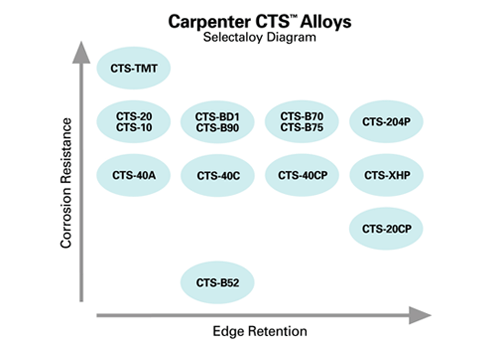Blade Alloys 101: What You Need to Know About the Alloys Used for Knife Blades
White Papers
When choosing a knife to purchase, do you consider the steel that is used in the blade and how it was fabricated?
Making an informed purchasing decision by choosing the right knife for your needs can become easier if you have a basic understanding of alloys used in the blades, how they are fabricated and the impact they can have on performance.
Types of Blade Fabricators
What blade fabricators generally look for in the alloys they use often depends on what kind of fabricator they are. For example, larger, high volume blade fabricators are likely to use different alloys than lower volume, specialty blade makers. The same is true when comparing the metal needs of forgers with those of stock removal fabricators – fabricators who take a piece of steel, profile it to create the basic shape and then heat treat it and finish it.
Fabricators have to strike a balance between working with familiar alloys and offering their customers “the latest and the greatest” product available. In either case, they need to be confident that they have an alloy that will be consistent knife blade to knife blade. Many knife blade fabricators take pains to be the first ones to market a blade using a new alloy or a unique design. Therefore, alloy producers must constantly refine and expand their product lines.
In October 2009 Carpenter Technology introduced the Carpenter Technology CTS™ suite of blade alloys comprised of 14 alloys offering superior edge retention, surface finish and machinability as well as consistent heat treatability when used for various knife blade applications. The CTS alloys can be classified into three families: low alloy martensitic stainless steels, bearing steels and powder metals.
Low Alloy Martensitic Stainless Steels
Low alloy martensitic stainless steels, such as the 410 and 420 families of stainless alloys, are currently popular with blade fabricators. These stainless steels tend to contain about 0.6 percent carbon and 12 to 18 percent chromium.
Due to the simplistic nature of these alloys, they tend to be the most modified ones across the blade alloy spectrum. By adding a “pinch” of various alloying ingredients, such as molybdenum, vanadium, tungsten and/or niobium, different characteristics can be achieved such as different levels of edge retention, machinability, sharpenability and corrosion resistance. Martensitic stainless steels tend to cost less and be more available than other types of blade alloys.
The martensitic stainless steels in the Carpenter Technology CTS alloy suite are Carpenter Technology CTS 10 (Type 410), Carpenter Technology CTS 20 (Type 420), Carpenter Technology CTS 40A (Type 440A), Carpenter Technology CTS B90 (X-90 stainless), Carpenter Technology CTS TMT (Trinamet® stainless) and Carpenter Technology CTS BD1. Carpenter Technology CTS BD1 alloy is a premium melted, martensitic stainless having better edge retention than CarTech CTS 10, Carpenter Technology CTS 20 and Carpenter Technology CTS 40 while still having good machinability. It is expected to be an upgrade to these alloys, making Carpenter Technology CTS BD1 an attractive possibility to cutlery makers.
Bearing Steels
Bearing steels tend to have more carbon than martensitic stainless steels and are more heavily alloyed to increase abrasive wear resistance or edge retention. These alloys contain the same alloying ingredients as martensitic stainless steels but tend to be 0.3-1.0 percent carbon and 1 percent or more chromium.
Carpenter CTS bearing steels are Carpenter Technology CTS B52, Carpenter Technology CTS 40C (440C) and Carpenter Technology CTS B70 (CRB-7) and CTS B75 (S42700).
Powder Metal Alloys
Powder metal alloys are very wear resistant, taking over at the upper end of bearing steels, and can be considered for certain specialty blade applications. Originally specified for extreme, demanding wear applications, powder metal alloys are more expensive, more difficult to machine and more difficult to sharpen.
The powder metals in the Carpenter Technology CTS alloy family are Carpenter Technology CTS 40CP, Carpenter Technology CTS 204P, Carpenter Technology CTS 20CP and Carpenter Technology CTS XHP.
Which Alloy?

Knife fabricators know when it comes to blade alloys there are tradeoffs. If the fabricator chooses an alloy offering better edge retention, the blade will be increasingly difficult for them to process and for consumers to sharpen. Likewise, edge retention may be sacrificed to obtain greater corrosion resistance. Carpenter’s Selectaloy® method diagram helps fabricators see the potential tradeoffs alloy by alloy and compare to alloys they already use.
For example, a fabricator can take an alloy with which they are familiar, such as 420 stainless, and move up or down the diagram with respect to the desired characteristics of an alloy. There are certain aspects of blade alloy selection that remain invisible to the most savvy blade fabricator or consumer. One example is the cleanliness of an alloy. Only the most discriminating steel junkie can tell how free an alloy is from deleterious elements as sulfur, phosphorus, tin, lead and bismuth – elements that could adversely affect the performance of the blade.
One way to pull back the cloak of invisibility is to know the alloy suppliers and the reputation of the alloys they produce. Carpenter adheres to tight chemistry ranges for each alloy it manufactures and implements stringent control over what goes into and what does not go into the alloy mix.
Many Carpenter alloys are vacuum melted, eliminating much of the “dirt” associated with air melting processes. As a result, the alloys have fewer unwanted inclusions and better characteristics, such as polishability.
***
By Rick Gleixner, Metallurgist
Carpenter Technology Corp., Wyomissing, Pa